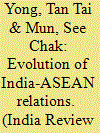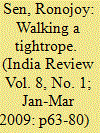|
|
|
Sort Order |
|
|
|
Items / Page
|
|
|
|
|
|
|
| Srl | Item |
| 1 |
ID:
087512


|
|
|
|
|
| Publication |
2009.
|
| Summary/Abstract |
Relations between India and Southeast Asia have deep historical
roots. For centuries, trade and human migration traversed the Bay of
Bengal and the Indian Ocean connected maritime Southeast Asia and
the Indian subcontinent in complex networks that were sustained by
commerce, culture, and community. As a consequence, large parts of
Southeast Asia came under profound Indian influences. British imperialism
strengthened these networks by bringing the subcontinent and
the territories to its east under the colonial sphere of influence, underpinned
largely by trade and commerce. In the 1940s, as India headed
towards political independence, Jawaharlal Nehru had looked to
Southeast Asia as a region whose history, fate, and destiny are somewhat
linked with India's. Great civilizations had once flourished in
these regions, but their destinies had been suppressed by long periods
of colonial rule. He believed that the world had been transformed by
the Second World War, and in the twilight of European imperialism
and the emergence of Asian nationalism, the peoples of India and
Southeast Asia would rediscover their own identities. As the first
Asian country to achieve independence from European colonial rule,
India was regarded by Southeast Asian nationalists, most of whom
had aspirations to follow in India's footsteps, as a natural leader of
an impending free and resurgent Asia.
|
|
|
|
|
|
|
|
|
|
|
|
|
|
|
|
| 2 |
ID:
087511


|
|
|
|
|
| Publication |
2009.
|
| Summary/Abstract |
This paper will provide a survey of India's foreign policy from 1947
to the present day. It is divided into three distinct historical sections.
It will also attempt to explain the underlying reasons for these policies,
India's initial orientation, and subsequent shifts that occurred over
time. The first section deals with the period from 1947 to 1962, the
second from 1962 to 1991 and the third from 1991 to the present. The
choice of these three segments is far from arbitrary. The first period
constituted the most idealistic phase of India's foreign policy under
the tutelage of India's first Prime Minister, Jawaharlal Nehru. The
second began with India's disastrous defeat in the 1962 Sino-Indian
border war. This period saw a gradual shift away from the early idealism
that had characterized the country's foreign policy and the adoption
of an increasingly "self-help" approach to foreign policy while retaining
elements of the Nehruvian rhetoric.1 The third phase began with the
end of the Cold War and the adoption of a more pragmatic foreign
policy hewing closely to the principles of Realism.
|
|
|
|
|
|
|
|
|
|
|
|
|
|
|
|
| 3 |
ID:
087513


|
|
|
|
|
| Publication |
2009.
|
| Summary/Abstract |
In Reorient: Global Economy in the Asian Age, Andre Gunder Frank
reminds us that in the centuries from 1400 to 1700, the Asian power
centers located in the Indian Subcontinent and China accounted
for the lion's share of global GDP, world trade flows, and capital
accumulation.1 The economic dynamics of the heyday of European
imperialism upended that, transferring the locus of power and capital
to Europe, and more specifically England. Railing against the colonial
period's skewed economic dynamics became a motivating force of the
nationalist movement, spurring Indian leaders to demand sovereignty
over decision-making, above all in economic affairs. For roughly three
decades after independence, the Indian state led by Nehru evolved a
foreign economic policy built on the conjoined principles of economic
self-reliance and political non-alignment. From the late 1950s to the
late 1970s, the high walls that came to surround the Indian economy
almost entirely shielded it from the eddies of economic activity across
the globe. India's goal was to undertake industrialization and modernization
without significant foreign intervention or assistance - to
extend the nationalist-era motto of self-reliance or swadeshi into all
realms of development. Nevertheless, capital scarcity made external
assistance necessary, so within this closed economic framework, the
Indian state found it had to interact strategically with both Cold War-era
power blocs, as well as multilateral institutions, when necessity
demanded and opportunity allowed.
|
|
|
|
|
|
|
|
|
|
|
|
|
|
|
|
| 4 |
ID:
087515


|
|
|
|
|
| Publication |
2009.
|
| Summary/Abstract |
The Indian state has been more penetrated by social actors than many
East and Southeast Asian states. Unlike China, India could neither
abolish private enterprise nor could it embrace globalization with the
same speed and ferocity. Both complete state-driven nationalization
and state-driven globalization would demand a state, which would
have much greater command over interest groups like industrialists,
farmers and trade unions. Policies favoring economic growth and
development in India needed to evolve gradually after building a
social consensus on those policies. This is a model of development
driven by a relationship between the state and society, where the
power of the state, even in its commanding moments, was moderated
by the power of social actors.
Developmental ideas were debated within the state. Substantial
economic policy change would require building upon a historical path
of gradual changes in ideas and policies, punctuated by economic crises.
This paper demonstrates how this dynamic is critical for explaining
the politics of the green revolution and consequent self-sufficiency in
food grains, as well as for understanding the India's globalization
beyond 1991. It is a story of getting to higher rates of economic
growth in a gradual and circuitous way after building a policy consensus
among diverse stakeholders. Economic crises aided the arrival of a
new consensus.
India's growth rates began looking more like China's after 2003.
Figure 1 gives us a visual feel of the trajectory of India's growth.
Between 1956 and 1974, India's GDP grew between 3 and 4 percent
per annum, when it was a closed and highly regulated economy.
|
|
|
|
|
|
|
|
|
|
|
|
|
|
|
|
| 5 |
ID:
087514


|
|
|
|
|
| Publication |
2009.
|
| Summary/Abstract |
The judiciary, particularly the Supreme Court, occupies an everincreasing
presence in the Indian landscape. The Court not only plays
an important adjudicatory role in a host of areas, but also actively
intervenes and shapes public policy and governance. Indeed, it has
waded into a bewildering variety of issues from the micro to the macro
level. In a remarkable judgment delivered in 2007 by a two-judge
bench of the Supreme Court, Justices A. K. Mathur and Markanday
Katju deviated from the case before them and pronounced:
Recently, the Courts have apparently, if not clearly, strayed into
the executive domain or in matters of policy. For instance, the
orders passed by the High Court in recent times dealt with subjects
ranging from nursery admissions, unauthorized schools, criteria for
free seats in schools, supply of drinking water in schools, number
of free beds in hospitals on public land, requirements for establishing
a world class burns ward in the hospital, the kind of air
Delhites breathe, begging in public, the use of sub-ways, the
nature of buses we board, the legality of constructions in Delhi,
identifying the buildings to be demolished, the size of speedbreakers
on Delhi roads, auto-rickshaw over-charging, growing frequency
of road accidents and enhancing of fines etc.
|
|
|
|
|
|
|
|
|
|
|
|
|
|
|
|
|
|
|
|
|